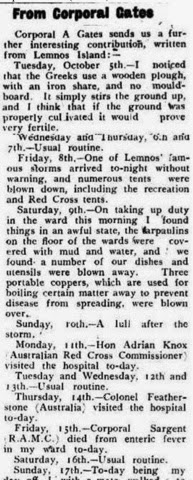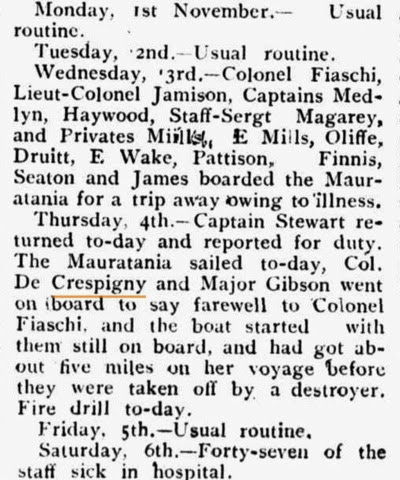This week’s Sepia Saturday blog prompt is an illustration of a little boy sick in bed.
I have no pictures of sick children who are related to me, but in my family tree there are many instances of childhood deaths from illness.
During my childhood, I suffered appendicitis and was hospitalised but had no major infection, though I think I remember suffering from chicken pox. I can remember my brother having the mumps and having his tonsils out when he was small.
My parents both spoke of serious illnesses in their childhood. Among these illnesses, my father had scarlet fever and my mother diphtheria. My father was an only child and my mother has one sister – neither suffered the death of a sibling.
The father of my husband Greg was an only child, but Greg’s mother had several brothers and sisters including one,
Gwendolyn Phyllis Sullivan (6 January 1933 – 30 May 1935), who died young. Marjorie, Greg’s mother, had helped to care for Gwendolyn and never forgot her little sister who died of meningitis when only two. Marjorie, who was 13 years older, had left school to help look after Gwenny when she was born. Marjorie recalled the little girl was sick with stomach cramps on Monday and died on Wednesday; 30 May was in fact Thursday but perhaps she died early that morning. Gwendolyn is buried at Malmsbury cemetery, Methodist Comp. 2 Sect 1 Grave 164. It seems that she has no headstone.
(Judkins, Carol. “Malmsbury Cemetery.” Carol’s Headstone Photographs. Rootsweb, Apr. 2008. Web. 20 Sept. 2013. <http://www.rootsweb.ancestry.com/~ausvsac/Malmsbury.htm>.)
Greg’s paternal grandfather Cecil Young had one brother, one sister and three half-siblings. His sister
Caroline Young (June 1895 – 10 July 1895) died 2 1/2 weeks after she was born on 10 July 1895. The cause of death was given as “debility from birth”. She is buried in Timor cemetery.
Greg’s paternal grandmother Elizabeth Cross was one of ten children. They all lived to adulthood. Greg’s maternal grandfather Arthur Sullivan had four brothers and sisters, a half-sister and a half-brother, William Ernest Dare Morley, who died on 2 February 1880 at East Brighton of “congestion of the brain” aged 15 days. Greg’s maternal grandmother, Stella Esther Gilbart Dawson, was one of eight children, all of whom survived until adulthood.
Of my grandparents, only my maternal grandmother had a sibling who died young. Emil Oswald Manock was born on 17 April 1914 at Steglitz, Berlin and died there on 3 December 1914. My grandmother told me her brother died from “a hole in the heart”.
Our great grand parents’ generation
John Young, my husband’s great grandfather, had 12 siblings, five died young. The first child of George and Caroline Young was George Young who was born and died in 1854, probably at Beechworth. His birth and death predate civil registration in Victoria and there is no death certificate. He was remembered on each of his sibling’s birth certificates. Annie Young died 16 April 1873 aged 10 months of dysentery at Lamplough. In 1876 the Young family lost three children within a month. On 31 March Laura Young died aged 2 from diphtheria after an illness of 5 days. On 21 April her brother Edmund Young aged 6 years also died of diphtheria after an illness of 14 days. On 27 April Caroline Young aged 8 1/2 years died of scarletina maligna (acute scarlet fever) after an illness of 1 week.
Sarah Jane Way, the wife of John Young, had nine siblings of whom four died young. William John Way died aged 6 months on 18 January 1858 of “congestion of the brain” at East Collingwood, Melbourne. Mary Jane Way died age 4 months on 19 June 1859 of “cancer of the eye” also at East Collingwood. Martha Way died aged 13 months on 10 August 1875 of rubella at Parkes, New South Wales. Harriet Elizabeth Way died two days after her ninth birthday on 18 May 1879 of typhoid fever at Parkes.
Frederick James Cross had ten siblings. One died young. Thomas Bailey Cross aged 2 died at Carngham on 28 January 1875. In the photograph below taken about 1890, Thomas is represented by the dark cloth on the floor in the lower right hand corner of the picture. On the back of the photo his name was with those of his brother’s and sisters.
 |
| Ellen Cross and family about 1890. Picture from Gale Robertson, great grand daughter of Frederick James Cross and great great grand daughter of Ellen. |
Ann Jane Plowright, wife of Frederick James Cross, had six siblings. Two died young. John Plowright died on 20 January 1872 aged 4 days old after a premature birth at Homebush near Avoca, Victoria. Frederick Edward Plowright died aged 14 years at Homebush on 24 April 1878. He was cutting down a tree and it fell on him, breaking his neck. He died instantly.
Anne Morley had seven siblings. Five died young. William Morley born about 1849 and Peter Morley born about 1851 had both died in England before the family emigrated in 1853. Elizabeth Morley died at Collingwood Flat on 10 March 1854 aged 5 years old of “Tabes Mesenterica“: tuberculosis or swelling of the lymph glands inside the abdomen. Children became ill drinking milk from cows infected with tuberculosis. This is now uncommon as milk is pasteurised. (“Tabes Mesenterica (Meaning Of).” Encyclo Online Encyclopaedia. Encyclo, 2012. Web. 21 Sept. 2013. <http://www.encyclo.co.uk/define/tabes mesenterica>.) Harriet Ann Morley died at East Collingwood on 5 January 1858 of atrophy aged 15 months. Mary Jane Morley died age 3 in 1858.
Henry Dawson, the son of Isaac Dawson and Eliza Skerrit was born on 30 Jul 1864 in Corby, near Grantham, Lincolnshire, England. He had a twin brother, Charles, and at least eight other siblings, of whom one, George Dawson (1862 – 1863) died aged less than two years old.
Edith Caroline Edwards, daughter of Francis Gilbart Edwards and Caroline Ralph was born on 16 Sep 1871 in Sunnyside, Ballarat, Victoria. She had nine siblings of whom two died young. Benjamin Gilbart Edwards (1887 – 1888) was born in Ballarat and died aged 10 months at Richmond in Melbourne. Ernest Francis Gilbart Edwards (1891 -1901) died aged 10 in Brighton.
The siblings of my paternal great grandparents all survived to adulthood except one. Mary Jane Cudmore, one of 13 children, died aged 11 months on 20 November 1884 and is buried at Brighton cemetery, Adelaide.
I know only a little of the siblings of my maternal great grandparents and I have details only of those that survived to adulthood. It may be that they all did survive, but more research is needed to be sure.
I don’t have enough details to look back one further generation to the siblings of my and my husband’s great great grandparents. While I have details about a few of the families, information on others is missing. Hence I shall mention only one death from that generation.My great great great grandfather wrote about the death of his son at Heathcote and sketched his grave. The headstone, although damaged, still survives.
 |
| Sketch by Philip Lamothe Snell Chauncy of the grave of his son Philip who died at Heathcote aged 3 years. From opposite page 33 of his book Memoirs of Mrs. Poole and Mrs. Chauncy |
Philip Lamothe Chauncy (23 March 1851 – 19 May 1854) was the first son of Philip Lamothe Snell Chauncy and his wife Susan Mitchell. He died before my great great grandmother, Annie Frances Chauncy was born. In his memoir about his wife, Philip wrote:
… our first son, named Philip Lamothe, was born on the 23rd March, 1851. I think my dear Susie’s maternal instincts were unusually strong, and oh how true she was to them! How devoted she was to that child! He grew up to be a lovely boy, the admiration of all who knew him; but he had too heavenly a look for this world. He was the source of the most inexpressible delight to his mother; her eyes used to feast on his beaming little face; she looked the most un-utterable blessings on him. But alas, he was too exotic a plant to live on this earth, and was taken from us by our all-wise God, at Heathcote, Victoria, on the 19th of May, 1854. To the day of her death, his words and looks and little actions were fresh in her memory. I think she never completely recovered from the shock occasioned by the death of our little Philip; indeed, I now remember she said, shortly before she was taken from us, that she had never got over it, although she was quite resigned to the will of God, and would not have been so selfish as to have wished him back again. (Chauncy, Philip Lamothe Snell Memoirs of Mrs Poole and Mrs Chauncy. Lowden, Kilmore, Vic, 1976.Pages 37-8)
In May 1854, our darling little Philly caught cold, and Dr Sconce, the Government Assistant Surgeon, was called in to attend him. On the 12th of that month, Dr Robinson happening to be in our parlor-tent, and hearing Philly cough, said, “That child has croup.” O what agony the information caused his dear mother. A day or two after this we removed him into the large new stone building which had just been erected for officer’s quarters, but he gradually sank, and expired on the 19th May 1854, after a week’s illness. (Chauncy Memoirs already cited, page 47)
Most of our forebears came from Victoria and we are fortunate in the high quality of vital records which provide a lot of information for family history. In the summary below, where cause of death is not stated I have not obtained the death certificate.
Summary of our aunt, great aunts and uncles and great great aunts and uncles who died as children :
Aunt :
- Gwendolyn Phillis Sullivan died age 2 in 1935 of meningitis
Great aunt and great uncles :
- Caroline Young died age 2 1/2 weeks in 1895 of “debility from birth”
- William Ernest Dare Morley died age 15 days in 1880 from “congestion of the brain”
- Emil Oswald Manock died age 7 1/2 months in 1914 of a “hole in the heart”
Great great aunts and great great uncles :
- George Young died as an infant in 1854
- Annie Young died age 10 months in 1873 from dysentery
- Laura Young died age 2 in 1876 from diphtheria
- Edmund Young died age 6 in 1876 from diphtheria
- Caroline Young died age 8 in 1876 from scarletina maligna
- William John Way died age 6 months in 1858 of “congestion of the brain”
- Mary Jane Way died age 4 months in 1859 of “cancer of the eye”
- Martha Way died age 13 months in 1875 of rubella
- Harriet Elizabeth Way died age 9 in 1879 of typhoid
- Thomas Bailey Cross died age 2 in 1875
- John Plowright died age 4 days in 1875 having been born prematurely
- Frederick John Plowright died age 14 years in 1878 from an accident
- William Morley died as an infant or small child before 1853
- Peter Morley died as an infant or small child before 1853
- Elizabeth Morley died age 5 in 1854 from Tabes Mesenterica
- Harriet Ann Morley died age 15 months in 1858 of atrophy
- Mary Jane Morley died age 3 in 1858
- George Dawson died before he was 2 in 1863
- Benjamin Gilbart Edwards died age 10 months in 1888
- Ernest Francis Gilbart Edwards died age 10 in 1901
- Mary Jane Cudmore died age 11 months in 1884































